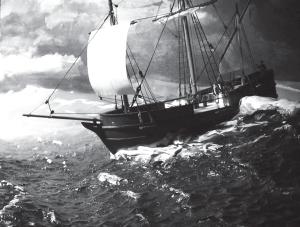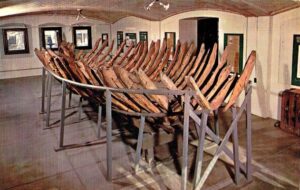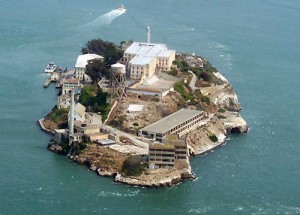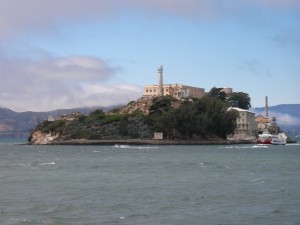waters
 The dangers of the Cape Cod shoals are well known to the seamen who regularly navigate those waters. Almost from the time the shoals were discovered, they have been wreaking havoc on the ships that have the misfortune of getting too close to them. Sailors know that they need to steer clear of the Cape coast. Thousands of ships have been destroyed on its bars and rocks, and with the lost ships, uncounted lives too have been lost in the storm-tossed waves. When the storms were raging and a ship got caught, there was no way for rescuers to get to the trapped crew and passengers. The storms battered the trapped ships until they sank.
The dangers of the Cape Cod shoals are well known to the seamen who regularly navigate those waters. Almost from the time the shoals were discovered, they have been wreaking havoc on the ships that have the misfortune of getting too close to them. Sailors know that they need to steer clear of the Cape coast. Thousands of ships have been destroyed on its bars and rocks, and with the lost ships, uncounted lives too have been lost in the storm-tossed waves. When the storms were raging and a ship got caught, there was no way for rescuers to get to the trapped crew and passengers. The storms battered the trapped ships until they sank.
Oddly, Cape Cod is both a hazard and a haven to the mariners. All shipping between Boston and New York must either pass into its sheltered bay or run aground on its treacherous shoals. It is only the skill of the mariners that determines the difference. The shoals, when combined with the forces of  countless Nor’easters put the Cape in a precarious location. Because of this, the Cape has been the site of more than 3,000 shipwrecks in 300 years of recorded history.
countless Nor’easters put the Cape in a precarious location. Because of this, the Cape has been the site of more than 3,000 shipwrecks in 300 years of recorded history.
One of the first recorded wrecks was that of the Sparrow Hawk. The Sparrow Hawk originally hailed from London, England. It was making a six-week voyage to Virginia when it ran aground off Nauset Harbor in 1626. A gale arose and forced the vessel over the bar into the harbor. The ship ran aground near Orleans. The area isn’t always so dangerous. When the tide is low, people aboard the ships were able to get ashore safely when their ships ran aground. When Sparrow Hawk grounded, some English-speaking Indians arrived and offered to conduct them to Plymouth or carry a message. Grateful, they accepted and once ashore, they sent a message which brought Governor William Bradford with repair material. The ship was soon repaired, but before it could set sail, the ship was sunk by another storm. The sunken ship was abandoned.

The second wreck would be more permanent, as the ship wasn’t seen for over 200 years. The wreckage reappeared on May 6, 1863, after the sand shifted. The exposed remains of the ship reappeared only briefly. Because of the vessel’s unusual shape, two local men made a drawing of it. The ship was an oddity, and it drew many visitors. The visitors, when they came to see, nearly all took a fragment of the ship for a souvenir before it was again covered by sand in August of 1863. Since they now knew where the ship was, it has since been excavated, and the ribs of the ship were removed and transferred to the Pilgrim Hall Museum in Plymouth, where it is to this day.
 On a trip to San Francisco, my husband, Bob and I took a tour of Alcatraz Prison. I expected it to be a usual touristy place, even though it had been the nation’s end of the line maximum security prison. It was where they sent the most incorrigible inmates. When we arrived, the island known as The Rock or America’s Devil Island to the inmates who did time there, really looked more like an industrial island than a prison, but you could see why it was called The Rock. Of course, that first view of the island was the last time I thought it didn’t look like a prison.
On a trip to San Francisco, my husband, Bob and I took a tour of Alcatraz Prison. I expected it to be a usual touristy place, even though it had been the nation’s end of the line maximum security prison. It was where they sent the most incorrigible inmates. When we arrived, the island known as The Rock or America’s Devil Island to the inmates who did time there, really looked more like an industrial island than a prison, but you could see why it was called The Rock. Of course, that first view of the island was the last time I thought it didn’t look like a prison.
Upon stepping inside, you felt an immediate, almost claustrophobic sensation, and I’m not claustrophobic. The cells were often painted black inside. It was a way of achieving privacy for the inmate. To me it just seemed bleak. I could imagine how it must have been…knowing that you could not leave this dark and ominous place. Alcatraz operated from the mid 1930s to the mid 1960s, and housed over 200 inmates. Well known for it’s brutal conditions, Alcatraz was thought to be inescapable due to the frigid waters of the bay. One group of prisoners either died or proved the rumors wrong, when they escaped and were never heard from again. Their fate is still unknown. The prisoners had to comply with very strict rules, and were required to live in complete silence. The first metal detectors were used at Alcatraz. No wonder the prisoners considered escape, knowing it meant almost certain death. Eventually, the conditions and treatment of the prisoners were deemed cruel and unusual punishment, and on March 21, 1963.
First explored by Juan Manuel de Ayala in 1775, it was originally called Isla de los Alcatraces, which meant  Island of the Pelicans. It was sold to the government in 1849. The first lighthouse in California was on Alcatraz. It was once a Civil War fort and then a military prison in 1907. Finally it became the maximum security prison known as The Rock. After it’s closing, a group of Sioux Indians claimed that the island belonged to them due to a 100 year treaty. Those claims were ignored until November of 1969 when a group of Native Americans representing the American Indian Movement, or AIM occupied the island. They stayed until 1971 when they were finally forced off of the island by federal authorities. The next year it was added to the Golden Gate National Recreation Area and opened for tourism. It was a very interesting tour to say the least.
Island of the Pelicans. It was sold to the government in 1849. The first lighthouse in California was on Alcatraz. It was once a Civil War fort and then a military prison in 1907. Finally it became the maximum security prison known as The Rock. After it’s closing, a group of Sioux Indians claimed that the island belonged to them due to a 100 year treaty. Those claims were ignored until November of 1969 when a group of Native Americans representing the American Indian Movement, or AIM occupied the island. They stayed until 1971 when they were finally forced off of the island by federal authorities. The next year it was added to the Golden Gate National Recreation Area and opened for tourism. It was a very interesting tour to say the least.

